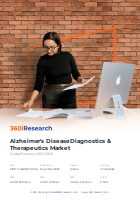
Alzheimer's Disease Diagnostics & Therapeutics Market by Product (Diagnostics, Therapeutics), Drug Class (Cholinesterase Inhibitors, Monoclonal Antibodies, NMDA Receptor Antagonists), Patient Demographics, Disease Stage, End User, Distribution Channel - Global Forecast 2025-2030
SKU
MRR-742BD517AA98
Region
Global
Publication Date
December 2025
Delivery
Immediate
2024
USD 8.35 billion
2025
USD 9.12 billion
2030
USD 14.41 billion
CAGR
9.50%

Download a Free PDF
Get a sneak peek into the valuable insights and in-depth analysis featured in our comprehensive alzheimer's disease diagnostics & therapeutics market report. Download now to stay ahead in the industry! Need more tailored information? Ketan is here to help you find exactly what you need.



